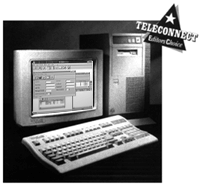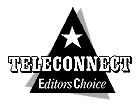|
VoiceGate Technologies' (Ontario, Canada -- 800-668-2387/905-747-2209)
VIP4000 is an auto attendant/voice-mail system that starts
at two ports and grows to support a total of 24 ports and
68 hours of voice storage. It ships on a 486 PC with 4 megs
of RAM and 850 MB hard drive. While the VIP4000 packs plenty
of standard features, what really impressed us is how easy
it is to install, program and run the system.
For the test drive, we set up a four-port system and connected
it, via analog ports, to a Avaya Technologies Partner key
system (the VIP4000 supports dozens of different phone systems).
The documentation you get with the VIP4000 is great. Their
Integration Notes for specific phone systems detail how to,
among other things, program your switch to create a voicemail
hunt group (assigning extensions and defining hunt groups).
They also include a Basic Start-Up Checklist to help get you
up and running quickly.
 |
|
VoiceGate's VIP4000 is a powerful,
easy to program auto attendant/voicemail system. You
get, among other things, excellent multi-tenant features,
fax detection, the ability to record conversations,
support for several different languages and optional
fax-on-demand.
|
PROGRAMMING THE VIP4000
The VIP4000 runs on DOS and uses pull-down menus to guide
you through setting up and running its features and capabilities.
We found it very user-friendly and a lot easier to program
than other voicemail systems we've seen.
Besides the excellent integration and start-up notes, the
system's manual is also easy to understand and shows detailed
pictures of programming screens. Getting started and basic
things like adding new users (entering their names, extensions,
classes of service, etc) is a no-brainer.
You can create up to 30 different classes of service for
users on the system. The pull-down menus provide fields for
setting up and enabling various things like Message Notification
(it has a cascading notification feature to call you at home,
on your cell phone, etc.--up to five numbers--when you get
a message); Message Age (when to automatically purge messages
if not erased by the user) and Record Conversation (system
administrators can enable or disable this feature here).
Two neat things we liked about the class of service choices
were the Extension Change and the Prompt Before/Prompt After
features. Let's say someone in your office changes workspaces,
moves to another floor, etc., and gets assigned a new extension.
The Extension Change feature plays a message to callers, for
up to 90 days, saying this person is now at extension XXX
and then the VIP4000 automatically sends the caller to the
new extension. When telcos do this, it's called "permissive
dialing".
With the Prompt Before and Prompt After features, you can
decide whether or not to play various prompts (Press Zero
for the operator at anytime, Press 5 to transfer to another
extension, etc.) before and after people leave messages in
a mailbox. This could be a real customer-pleasing thing, especially
for repeat callers who are familiar with your system or for
those folks (impatient New Yorkers like me!) who just want
to quickly get in and out of mailboxes.
MULTI-TENANTING AND SETTING
UP THE AUTO ATTENDANT
For office suites and other situations where different companies
or users (maybe different doctors in the same office) share
the voicemail system, the VIP4000 offers some excellent multi-tenanting
capabilities.
You can define different tenants (users) various ways, including
by port, time of day, day of week and day of year. Maybe Dr.
A's secretary covers for Dr. B's secretary during lunch. Calls
to Dr. B can be automatically sent to Dr. A based on the predefined
time entered into the VIP4000.
The VIP4000's multi-tenanting goes beyond just playing different
company greetings and then using the same call routing tree.
You can define day and night operators and send calls to their
extensions based on the time of day, day of week, etc.
Setting up the auto attendant features are also quite easy.
When the caller presses say digit one, they're sent to predefined
"levels" or menus. Tables guide you through setting
up the levels, extensions and hunt groups used to route calls.
A Time Out feature lets you send the caller to maybe a receptionist
or specific extension if the caller hasn't pressed any digits
after a certain amount of time.
USER STATISTICS AND FAXING
A neat feature shows you various user statistics like how
many messages someone received, the number of calls sent to
a mailbox and the total length of messages.
If faxing is your thing, the VIP4000 can detect a fax tone
and send it to an extension with a fax machine, saving you
dedicated lines. People also don't have to call into a mailbox,
listen to prompts and messages and wait for the "To send
a fax, Press 1" prompt, since the VIP4000 automatically
grabs the fax tone and transfers it.
An optional Fax-on-Demand capability lets you copy ASCII,
PCX and DCX files onto the VIP4000. Callers can then request,
and have faxed to them, specific documents. A Fax Statistics
screen shows you what documents were requested, a description
of the document, the fax number that called and the time and
date the document was requested. You can store up to 30 documents
of any length, up to hard drive capacity.
VoiceGate will build tailored, customized systems that, among
other things, use IVR. A two-port,
60 hour system starts at about $2,500.
| TELECONNECT
SEPTEMBER 1996 |
|



